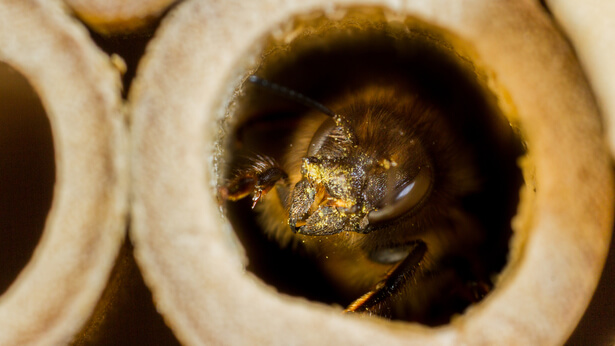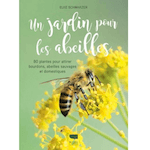When we talk about bees, we quickly think of the social colonies that domestic bees can form, a hive can shelter up to 50,000 individuals. But in reality, most bees do not live in colonies…
In fact, the so-called “solitary” or “wild” bees ensure the pollination of 80% of flowering plants, compared to 15% for domestic bees. They are outstanding workers: to pollinate a hectare of apple or almond trees, a hundred osmia bees will be enough when tens of thousands of domestic bees will be needed! Yet these excellent pollinisatrices are unfortunately threatened. Let’s help them by making them a cozy nest!
Why make a beehouse?
In the wonderful world of solitary beesyou will not see any queens or workers, but only males and females, quite simply. They appreciate our gardens where they forage, especially when we offer them a shelter worthy of the name to deposit their larvae.
A wild bee hotel © ndy119
However, these charming little bees are currently in decline, particularly due to the excessive use of pesticides. For naturalists, this is a most alarming observation, because Wild bees play a major role in pollinationwhether for our benefit or that of nature. More 80 % plant species need these pollinators.
Furthermore, due to the increasing destruction of natural habitats, animals have less and lessshelters to protect yourself from winterand nesting sites. However, certain places in your garden, but also on your balcony, in your orchard and even in your town or village can be very useful for this.
Read also: I am installing an insect hotel in my garden
How to make a 100% natural bee nest?
Some solitary bees quickly take over man-made nest boxes designed specifically to accommodate them.
A nest in a log
To make a nid 100 % naturelyou simply need a log of wood (birch, oak, beech) at least 15 cm long and 20 cm in diameter. Drill holes at least 10 cm deep, with a diameter varying from 5 to 10 mm, spacing them about 2 cm apart and avoiding completely piercing the log.
Finally, place the nest box at least 30 cm from the ground (do not exceed 3 m in height), in the sun, facing south, sheltered from bad weather, and preferably near a flowery area.
You will see, the cavities of the log will quickly please the pollinisatrices !
A nest made of hollow stems
Collect what are called ” hollow stems “, from plants such as brambles, black elderberry, bamboo or even reed.
Starting from the “knot” that separates one piece of the stem from another and which is therefore capped, measure at least 15 cm and cut. You thus obtain a tube ideal for wild bees, but also wild wasps! All that remains is to make a good forty of them.

A shelter for mason bees © thatmacroguy
Gather them together in a strong bundle using wire or something else and place everything in a tube such as a gutter pipe, a drain pipe, etc.
Finally, place the nest box at least 30 cm from the ground (do not exceed 3 m in height), in the sun, facing south, sheltered from bad weather, and preferably very close to a flowery area.
The solitary bees will soon come and deposit their larvae there, closing the tube with earth, with chewed grass, flower petals, pieces of hay, etc.
Bees – Did you know?
- Only 25% of crops do not depend on the action of pollinating insects.
Want to help bees by planting honey-producing flowers to feed them? Join us, and let’s create areas for them…


This practical guide explains how to create a welcoming garden by planning the choice of plants and their flowering period. The garden thus becomes a refuge for these insects that certain flowers attract better than others.
Article updated
consoGlobe also recommends…
Source: www.consoglobe.com


